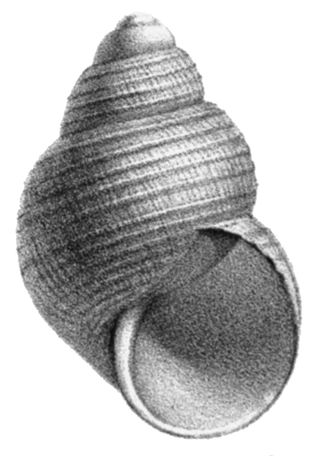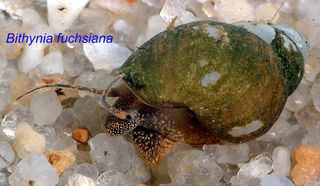
Trematoda is a class of flatworms known as flukes or trematodes. They are obligate internal parasites with a complex life cycle requiring at least two hosts. The intermediate host, in which asexual reproduction occurs, is usually a snail. The definitive host, where the flukes sexually reproduce, is a vertebrate. Infection by trematodes can cause disease in all five traditional vertebrate classes: mammals, birds, amphibians, reptiles, and fish.

Clonorchis sinensis, the Chinese liver fluke, is a liver fluke belonging to the class Trematoda, phylum Platyhelminthes. It infects fish-eating mammals, including humans. In humans, it infects the common bile duct and gall bladder, feeding on bile. It was discovered by British physician James McConnell at the Medical College Hospital in Calcutta (Kolkata) in 1874. The first description was given by Thomas Spencer Cobbold, who named it Distoma sinense. The fluke passes its lifecycle in three different hosts, namely freshwater snail as first intermediate hosts, freshwater fish as second intermediate host, and mammals as definitive hosts.

Opisthorchis felineus, the Siberian liver fluke or cat liver fluke, is a trematode parasite that infects the liver in mammals. It was first discovered in 1884 in a cat's liver by Sebastiano Rivolta of Italy. In 1891, Russian parasitologist, Konstantin Nikolaevich Vinogradov (1847–1906) found it in a human, and named the parasite a "Siberian liver fluke". In the 1930s, helminthologist Hans Vogel of Hamburg published an article describing the life cycle of Opisthorchis felineus. Felineus infections may also involve the pancreatic ducts. Diagnosis of Opisthorchis infection is based on microscopic identification of parasite eggs in stool specimens. Safe and effective medication is available to treat Opisthorchis infections. Adequately freezing or cooking fish will kill the parasite.

Bithynia tentaculata, common names the mud bithynia or common bithynia, or faucet snail is a relatively small species of freshwater snail with gills and an operculum, an aquatic prosobranch gastropod mollusk in the family Bithyniidae.

Liver fluke is a collective name of a polyphyletic group of parasitic trematodes under the phylum Platyhelminthes. They are principally parasites of the liver of various mammals, including humans. Capable of moving along the blood circulation, they can occur also in bile ducts, gallbladder, and liver parenchyma. In these organs, they produce pathological lesions leading to parasitic diseases. They have complex life cycles requiring two or three different hosts, with free-living larval stages in water.

Bithynia leachii is species of small freshwater snail with an operculum, an aquatic prosobranch gastropod mollusk in the family Bithyniidae.

Bithynia is a genus of small freshwater snails with an operculum, aquatic prosobranch gastropod mollusks in the family Bithyniidae.

Parafossarulus manchouricus is a species of freshwater snail with gills and an operculum, an aquatic prosobranch gastropod mollusk in the family Bithyniidae.

Echinostoma revolutum is a trematode parasites, of which the adults can infect birds and mammals, including humans. In humans, it causes echinostomiasis.

Puntius brevis, sometimes known as the swamp barb, is a species of ray-finned fish in the genus Puntius. It is found in the Mekong and Chao Phraya basins. Puntius spilopterus is sometimes considered conspecific.

Bithynia siamensis is a species of a freshwater snail with a gill and an operculum, an aquatic prosobranch gastropod mollusk in the family Bithyniidae.

Telogaster opisthorchis is an endoparasite in the class Trematoda within the phylum Platyhelminthes. This fluke is known for causing tumor like malformations in fishes by attaching onto its spinal region in the metacercariae form. Malformations cause fish to become more susceptible to fish eating predators allowing T. opisthorchis to continue with its lifecycle.

Bithynia fuchsiana is a species of small freshwater snail with a gill and an operculum. It an aquatic gastropod mollusk in the family Bithyniidae.
Bithynia longicornis is a species of freshwater snail with a gill and an operculum, an aquatic gastropod mollusk in the family Bithyniidae.
Bithynia misella is a species of freshwater snail with a gill and an operculum, an aquatic gastropod mollusk in the family Bithyniidae.
Parafossarulus spiridonovi is a species of freshwater snail with gills and an operculum, an aquatic prosobranch gastropod mollusk in the family Bithyniidae.
Parafossarulus anomalospiralis is a species of freshwater snail with gills and an operculum, an aquatic prosobranch gastropod mollusk in the family Bithyniidae.
Carcinogenic parasites are parasitic organisms that depend on other organisms for their survival, and cause cancer in such hosts. Three species of flukes (trematodes) are medically-proven carcinogenic parasites, namely the urinary blood fluke, the Southeast Asian liver fluke and the Chinese liver fluke. S. haematobium is prevalent in Africa and the Middle East, and is the leading cause of bladder cancer. O. viverrini and C. sinensis are both found in eastern and southeastern Asia, and are responsible for cholangiocarcinoma. The International Agency for Research on Cancer declared them in 2009 as a Group 1 biological carcinogens in humans.
Holostephanus dubinini is a species of parasitic trematode in the family Cyathocotylidae.













